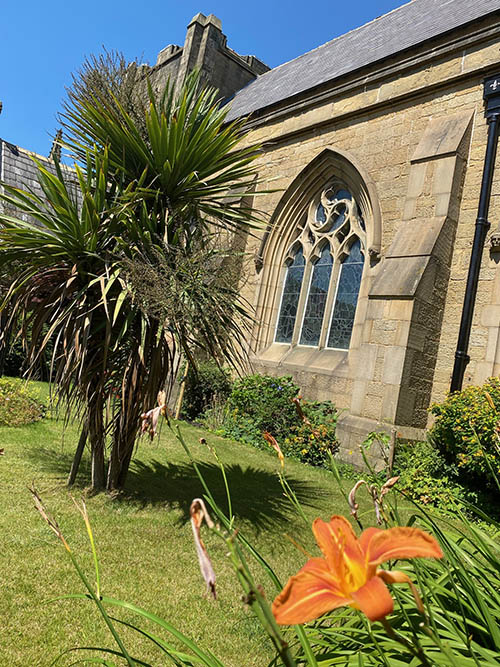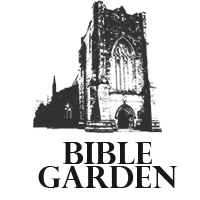Palm Tree
Map Position: 17There are about 181 genera and about 2600 species of palm trees.
The use of palm trees by humans is as old as human civilization itself. Dates have been used as food, they can be stored and transported easily, the trees provide shade and protection from strong winds. The wood, the bark, the leaves: all can be used for furniture, construction, and other purposes. The sap is used as beverage; to make alcoholic drinks, the resin is used as medicine etc.
The most important palm tree is probably the date palm which, however, struggles to grow in our northern climate. In St. Mary’s Bible Garden, you will, therefore, find other subspecies to remind us of the palm’s importance for people of the Bible.
Biblical

Moses rested at an oasis, “where there were twelve springs of water and seventy palm trees” (Exodus 15.27). The same is mentioned in Numbers 33.9.
The Lord instructs Moses on how to celebrate thanksgiving, which includes the use of palm branches (Leviticus 23.40 – see also 5. Willow).
When the storyteller Balaam saw the camp of the Jews, he praised its beauty as it looked like “palm groves that stretch afar, like gardens beside a river, like aloes that the Lord has planted” (Numbers 24.6).
Jericho, famous for its riches, is often called “the city of palm trees” (Deuteronomy 34.3, also in Judges 1.16 and 3.13, see also 2. Chronicles 28.15).
Deborah, a prophetess “used to sit under the palm” (Judges 4.5).
When Solomon built the sanctuary for the Lord, he only used the most precious materials, among others palm trees (1. Kings 6.29 – 35 and 7.36, see also 2. Chronicles 3.5).
During the holy time of the Feast of the Tabernacles, people of Israel should dwell in booths, made among other things of branches of palm (Nehemiah 8.15).
If you are a righteous man, you will “flourish like the palm tree” (Psalm 92.12-16, see also 11. Cedar).
Solomon compares the beauty of his beloved with a palm tree: “Your stature is like a palm tree, and your breasts are like its clusters. I say I will climb the palm tree and lay hold of its fruit…” (Song of Solomon 7.7 and 8).
Wisdom is compared to beautiful tall trees, it is “tall like a palm tree” (Sirach 24.14, RSV, see also 4. Plane and 11. Cedar).
The Lord punishes Israel for its arrogance by cutting off “head and tail, palm branch and reed in one day” (Isaiah 9.17) and makes the same threat to Egypt (Isaiah 19.15).
The unique beauty of the temple is again described by Ezekiel and all the precious materials used, including wood of palm trees (Ezekiel 40.16 -37 and 41.18 – 26).
The tribe of Ephraim “was like a young palm planted in a meadow” (Hosea 9.13) but suffered along with other Jews when their lives had been sinful.
It is a disaster when important trees such as palm trees wither (Joel 1.12, see also 9. Fig Tree, 1. Apple, and 23. Pomegranate).
Simon, the great High Priest and commander and leader of the Jews tried to find an ally in King Demetrius and sent him among other things a palm branch (1. Maccabees 13.37 in RSV). After Simon had conquered Gazar’a he entered the city with praise and palm branches (1. Maccabees 13.51 in RSV).
After the Jews had recaptured the Temple and Jerusalem, they thanked the Lord with a feast, “bearing […] beautiful branches and also fronds of palms” (2. Maccabees 10.7).
Al’cimus, a traitor, offered his support to an enemy of the Jews and gave him among other things a palm (2. Maccabees 14.4).
In the New Testament we read in John about Jesus’ entry into Jerusalem where people took palm branches to greet him (John 12.13). This is still celebrated as Palm Sunday.
The Lord is worshipped and praised by people with “palm branches in their hands” (Revelation 7.9).
